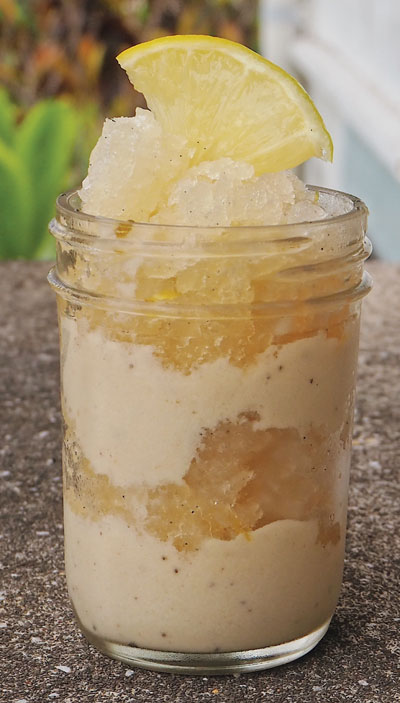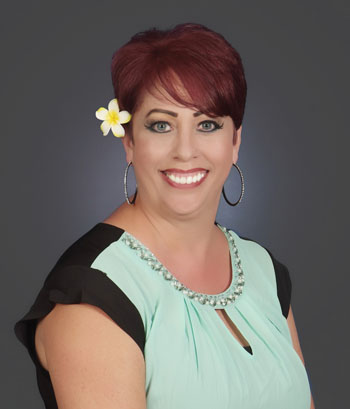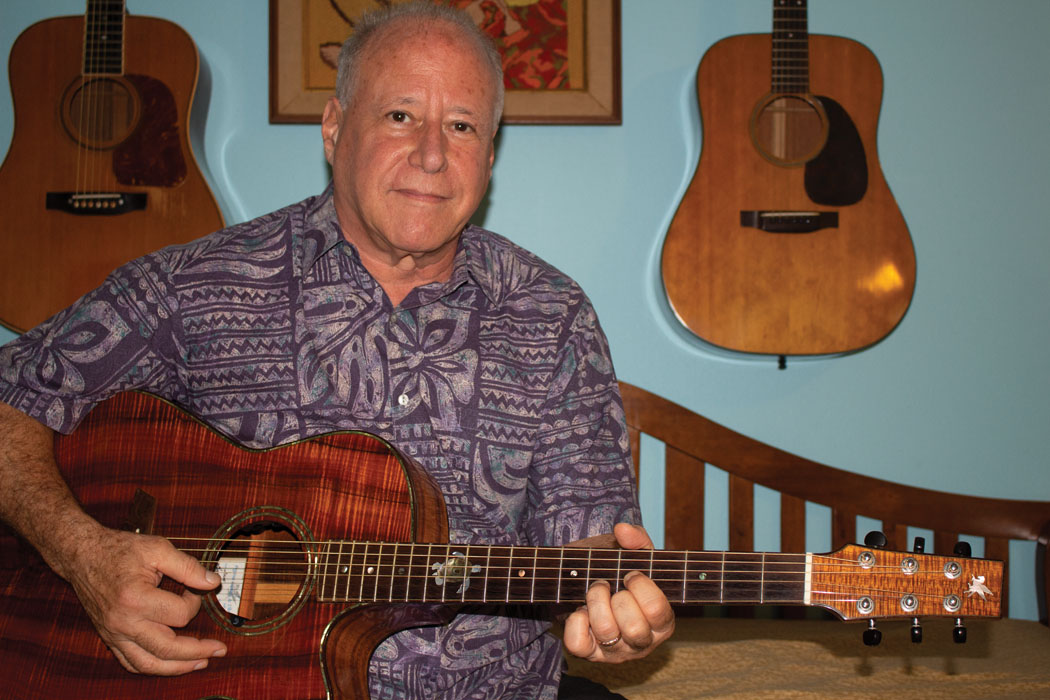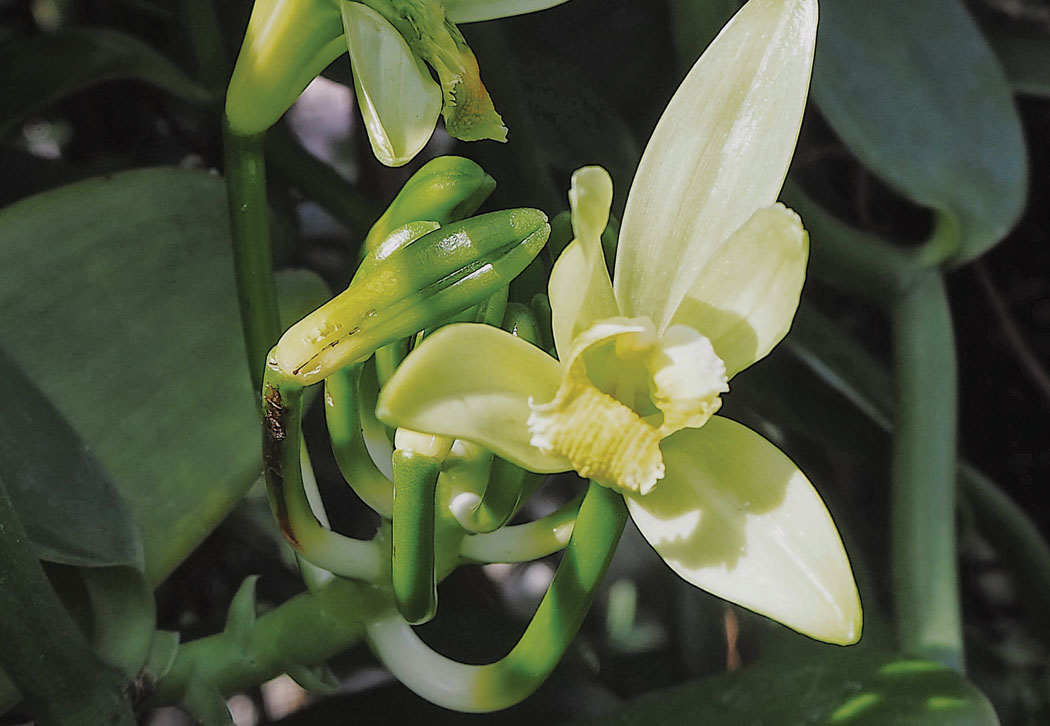
A Taste of Hawai’i Island’s Vanilla Industry: Anything but Plain

By Brittany P. Anderson

As the day’s first light sneaks over the horizon, a light green orchid blooms in a tangle of vines. A flurry of activity buzzes around the flower. With a swift hand, the orchid is pollinated, ready to create the most sought-after flavor in the world—vanilla.
Often synonymous with being plain or ordinary, vanilla is quite the opposite. Vanillin is just one of up to 250 chemical compounds that form the characteristic vanilla taste, making it one of the most complex flavors around. Some speculate that vanilla beans will out-price saffron this year as the most expensive spice on the planet.
Vanilla beans are a high-risk, labor-intensive product grown from a highly specific orchid, and each flower must be hand-pollinated. Hawai‘i Island’s humid tropical environment sets the perfect stage for vanilla cultivation, value-added products, and agritourism opportunities.
The Sweetest Orchid
In 1941, the late Tom Kadooka started propagating the Vanilla planifolia orchid at his nursery in Kainali‘u along the slopes of Mauna Loa. An avid orchid club member and nurseryman, Tom is the foundation of the island’s orchid industry. For decades he supplied residents with rooted vanilla plants and taught the art of vanilla orchid farming from his nursery. Tom stumbled upon his first vanilla vine growing wild in Ka‘ū, its origin unknown. Today, most of the vanilla farms on Hawai‘i Island can trace their vines back to Tom’s nursery and the mysterious Ka‘ū vine.
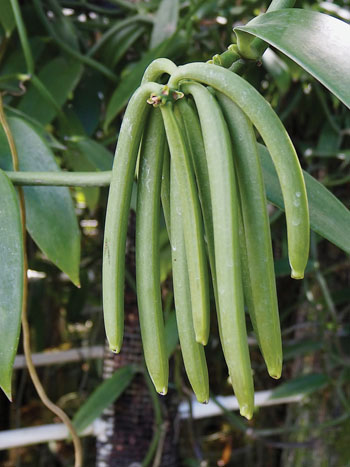
Vanilla orchids grow within 25 degrees of the equator, which means Hawai‘i is the only state in the US where it thrives. Originally from Mexico, it grows like a vine using tendril-like roots to grip tree trunks as it reaches towards the sky. Island producers use a variety of growing methods simulating vanilla’s natural habitat.
At Tom Sharkeyʻs cacao and chocolate farm in Papa‘ikou, vanilla climbs on cacao trees, while at Guy Cellierʻs Vanillerie in Kailua-Kona, shade houses are filled with cages, called tudors, for the vines to take hold. Consistency and shade are two of the essential components to successful vanilla crop yields. The alternating leathery leaves can easily succumb to sunburn, and inconsistent temperatures decrease flowering.
Vanilla orchid flowers grow in clusters, though each flower within the group can bloom at any time during the February through May season. Flowers bloom for two to four hours in the early morning and must be pollinated by hand before withering away.
The Melipona bee is thought to be the only species of insect that knows how to pollinate the vanilla flower. A tiny ball of pollen is locked away in the anther, and when the bee enters the flower, it nudges the anther, allowing the small ball of pollen to fall into the bottom of the flower where it fertilizes the ovules which grow one single vanilla bean. Melipona bees are rare, even in vanilla’s native habitat, so all vanilla available commercially is pollinated by hand.
The vine is propagated by cuttings and can take three to five years of careful tending before flowers are expected. Guy hits home the dedication needed before growers see any reward, explaining, “The biggest challenge is that vanilla is slow growing.” Vanilla farmers must tend to their orchids with the promise of something delicious for at least three years. Even then, vanilla beans take one year to develop before they can be harvested. Plump green beans dangle like fingers off the zigzag vines—a lesson in patience and a reminder that good things come to those who wait.

A Little Goes a Long Way

Vanilla lends its warm, rich taste to chocolate, most ice cream flavors, and fragrances. Flavor chemists can only identify and replicate seven of the 250 chemicals responsible for the characteristic taste of natural vanilla beans. Once you’ve had pure Hawai‘i Island vanilla, there’s no going back to artificial flavoring.
Ripe vanilla beans are a yellow color; it isn’t until they are blanched and sweat in the hot Hawaiian sun that they take on the typical brown appearance. Beans are further dried to a peak moisture content of 30%–35%. Hawai‘i Island growers typically offer their most substantial Grade A and B beans for sale and use smaller ones for value-added products.
Over at Huahua Farm, located near the village of Hōlualoa, in addition to selling beans—which sell out quickly—they offer jars of vanilla extract and vanilla-infused sugar for sale through their online store. Hawai‘i Island’s vanilla base is floral, complex, and naturally sweet, securing its place at the top of the vanilla connoisseur’s list.
The Vanillerie, as well as The Hawaiian Vanilla Co. located in Pa‘auilo, offer a seemingly limitless utilization of vanilla. From culinary application to beauty products, vanilla doesn’t just have to be the flavor on display. “I think more people should experiment with the savory side of vanilla,” says Jeanie of The Vanillerie. There, Jeanie features salt shakers, pepper grinders, and sugar scrubs all of whose contents are spiked with their vanilla.
The Hawaiian Vanilla Co., the first US commercial vanilla growers, boasts an expansive vanilla-based spice rub collection including a heavenly vanilla garam masala. For Hawai‘i Island’s vanilla farmers, it isn’t all about the products. Theyʻre also serving a growing demand for agritourism here on the island.
The Vanilla Experience
Hawai‘i Island agritourism is the perfect blend of the island’s two primary industries—tourism and agriculture. Farmers have found that offering tours helps to offset some of the high costs associated with farming, and enlightens visitors who are eager to get a closer look at where their food comes from.
At The Vanillerie, guests are taken through the process from cultivation to curing under a canopy of vines. The shade houses are a leisurely stroll and an eye-opening look at vanilla production.
“We were here last year and got to pollinate a flower, one of my vanilla beans is in here somewhere,” a gentleman from England remarked. The family returned to The Vanillerie to see the progress made in a year’s time. As the group walked the rows of tudors, with tour guide Steve leading the way, two flowers took center stage.
Each guest paused at the flowers, registering it in their minds before snapping a picture and moving on. Steve herds the group to an outbuilding where he demonstrates steps for processing. The intoxicating smell of vanilla envelops the tour as Steve opens the doors to The Vanillerieʻs walk-in humidor.
Guy and Jeanie have big plans for their vanilla plantation—in addition to planting more vanilla. Jeanie is creating an intimate meeting area for small gatherings, surrounded by the sight and smell of vanilla.
The Vanillerie tour ends sweetly with a cup of rich, creamy vanilla ice cream made for the plantation. Guests enjoy the treat as they ponder the experience and peruse items for sale. “We were never going to be huge producers…the way to add value was to do agritourism,” Guy says.
At The Hawaiian Vanilla Co., food is the main event, starting with refreshing vanilla lemonade. Culinary application of vanilla ranges at their luncheon and farm tour, exciting taste buds with every dish. Vanilla is a family affair for the Reddekopp family who started The Hawaiian Vanilla Co. in 1998. Their gift shop and luncheon areas are authentically homestyle as members of the Reddekopp family participate in all aspects of the company.
A short walk from the sunny yellow mill house, visitors get a peek of the family’s greenhouses. Vanilla processing has always been a family affair; pictures of Reddekopp’s children when they were young, placing labels on jars of vanilla on the farm blog echo Jim and Tracyʻs original plan to “raise great children and build a business together.” Patrons of the luncheon and farm tour at The Hawaiian Vanilla Co. feel the warm embrace of being a part of the Reddekopp family, even if just for an afternoon.
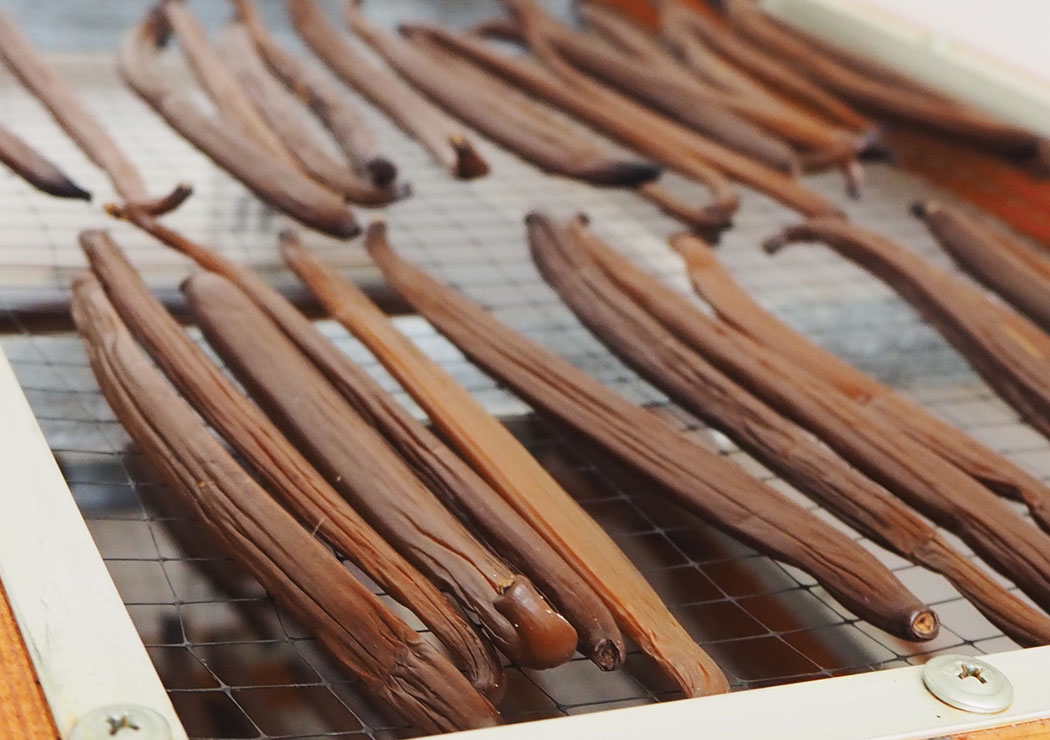
Vanilla Around the World
On the world’s stage, vanilla as a commodity is setting record prices. Madagascar farmers are demanding higher and higher rates, driving the cost of vanilla extract from $60 a gallon three years ago to now over $200 per gallon. Hawai‘i Island growers don’t and can’t compete with the large-scale vanilla plantations of Madagascar, Papua New Guinea, or Indonesia; nor do they want to.
Hawai‘i Island vanilla farmers, like The Hawaiian Vanilla Co., diversify their yield by creating high-quality vanilla products in addition to farm tours and bean sales. In comparison to other Hawai‘i Island agriculture ventures, vanilla takes significantly less space and can be trellised to a manageable height. But the labor involved in hand-pollination—if and when the orchid blooms—can be a setback for island growers. There is potential for growth in the Hawai‘i Island vanilla industry for those who are willing and patient.
The day comes to an end with the sweet smell of vanilla beans drying—their tantalizing fragrance sweeping over the rows of leathery green leaves coaxing out the next morning’s blooms. For Hawai‘i Island’s vanilla producers, it is just another day of vanilla season. ❖
For more information:
hawaiianvanilla.com
thevanillerie.com
huahuafarm.com
Mahalo Ahualoa Farms—Local Agricultural Story Sponsor
